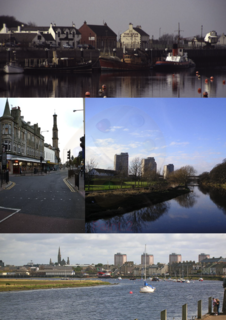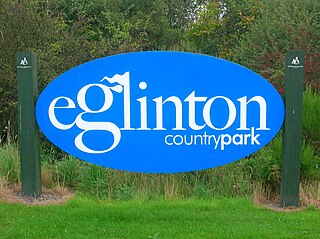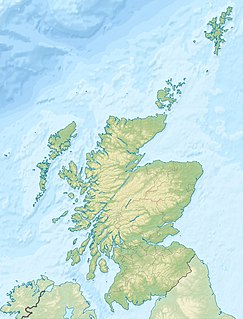The Irvine New Town Trail is a recreational cycleway and footpath around Irvine, North Ayrshire, Scotland. The route is 19 kilometres (12 mi) long. The trail is used by many dog walkers and cyclists in the area.

Irvine is an ancient settlement, in medieval times a royal burgh, and now a new town on the coast of the Firth of Clyde in North Ayrshire, Scotland. The 2011 Census recorded the town's population at 33,698 inhabitants, making it the largest settlement in North Ayrshire.

North Ayrshire is one of 32 council areas in Scotland. It has a population of roughly 135,800 people. It is located in the southwest of Scotland, and borders the areas of Inverclyde to the north, Renfrewshire to the northeast and East Ayrshire and South Ayrshire to the east and south respectively. North Ayrshire Council is a hung Council. North Ayrshire also forms part of the east coast of the Firth of Clyde.
The route forms a ring with no specific start and end points. Taken in a clockwise direction from the town's main Rivergate Centre, the trail runs beside the River Irvine through Irvine's Low Green, continues north beside the railway line past the Towns Moor and the Garnock Floods wildlife reserve, then goes along beside the River Garnock towards Kilwinning's Woodwynd and Blacklands area. At this point, it diverges from the Ayrshire Coastal Path, crossing the river along the route of the former Doura colliery branch line of the Ardrossan Railway before following the Lugton Water eastwards through Eglinton Country Park: a very popular area for recreational activities, with historical interest at Eglinton Castle.

The River Irvine is a river that flows through southwest Scotland. Its watershed is on the Lanarkshire border of Ayrshire at an altitude of 810 feet (250 m) above sea-level, near Loudoun Hill, Drumclog, and 7 miles (11 km) SW by W of Strathaven. It flows 29½ miles westward, dividing the old district of Cunninghame from that of Kyle, until it reaches the sea via Irvine Harbour in the form of the Firth of Clyde, and flows into Irvine Bay by the town of Irvine. It has many tributaries, some of which form parish, district and other boundaries.

The River Garnock, the smallest of Ayrshire's six principal rivers, has its source on the southerly side of the Hill of Stake in the heart of the Clyde Muirshiel Regional Park. About a mile and a half south of this starting point the untested stream tumbles over the Spout of Garnock, the highest waterfall in Ayrshire, once thought to be the river's origin. The river then continues, for a total length of 20 miles (32 km) or so, through the towns of Kilbirnie, Glengarnock, Dalry and Kilwinning to its confluence with the River Irvine at Irvine Harbour.

Kilwinning is a town in North Ayrshire, Scotland. It is on the River Garnock, north of Irvine, about 21 miles (34 km) south of Glasgow. It is known as "The Crossroads of Ayrshire". Kilwinning was also a Civil Parish. The 2001 Census recorded the town as having a population of 15,908. At the 2011 Census, Kilwinning had a population of 21,456.
The trail rejoins the disused Ardrossan Railway line at Sourlie Wood nature reserve, and follows the old track south through Girdle Toll in a cutting which formerly led to the Perceton colliery. The trail then runs beside the Annick Water, initially southwards through parkland and countryside to the east of Bourtreehill. It follows the river west in parkland between Broomlands and Dreghorn, using the disused Glasgow, Paisley, Kilmarnock and Ayr Railway trackbed past the site of the former Dreghorn railway station, then rejoins the River Irvine riverbank heading north back to the Rivergate shopping mall.

Girdle Toll is an area of Irvine, North Ayrshire.
Perceton is a medieval settlement and old country estate in North Ayrshire, Scotland, near the town of Irvine. The ruined church in Perceton is one of the oldest buildings in the Irvine district. The earliest legible gravestone dates from 1698, though older stone coffins will certainly still rest deep within the small hillock on which the chapel and graveyard sit.

The Annick Water is the largest tributary of the River Irvine. The river runs from Long Loch, just inside East Renfrewshire, in a generally south-western direction through North Ayrshire and East Ayrshire, to confluence with its parent river at Irvine, North Ayrshire on the west coast of Scotland. The name may derive from the Gaelic for 'overflowing' and Strathannick is very much prone to flooding as recorded by SEPA.
The route forms part of the national cycle network with routes 7 and 73 forming part of the route.









